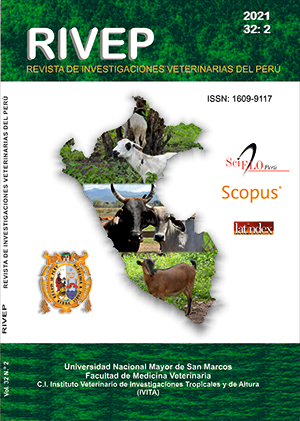Frequency and parasite load in gills of cachama fry (Colossoma macropomum) through direct examinations in three fish farms in Ucayali, Peru
DOI:
https://doi.org/10.15381/rivep.v32i2.20010Keywords:
fingerlings, cachama, ectoparasites, fish farms, direct examinations, UcayaliAbstract
The aim of this study was to determine the frequency and load of ectoparasites in gills of cachama fry from three semi-intensive farming fish farms in the province of Coronel Portillo, Ucayali, Peru. Sixty fingerlings (35-45 days old) were selected from each of the three fingerling supply establishments (E1, E2 and E3), reared at similar density and feeding conditions. Three fresh gill layer sections were evaluated from both sides, by visual observation with a 2x magnifying glass to detect crustaceans and by direct microscopy at 10x for trematodes and at 40x for protozoa. Four degrees of infestation were considered; null (0 parasites), mild (1-3), moderate (4-7) and severe (>8). It was possible to identify mainly forms compatible with monogeneans of the Dactylogyridae family, compatible with Dactylogyrus spp (41.1%) and protozoa, mostly of the Oodiniaceae family, compatible with Piscinodinium spp (10.6%). No crustaceans were found. The frequencies of infestations were 28.3, 86.7 and 18.3% in E1, E2 and E3, respectively. Parasitic loads were mostly light (87.5, 53.8 and 83.3% for monogeneans and 80, 70 and 100% for protozoa, in E1, E2, and E3, respectively). The results suggest a lower sanitary condition in the E2 fingerlings. It is concluded that there was a higher frequency of infestations by monogeneans and light parasite loads in gills of cachama fry from the three fish farms evaluated by direct examinations.
Downloads
Downloads
Published
Issue
Section
License
Copyright (c) 2021 Juan Rondón E., César Villanueva C., Roberto Del Águila L., Nieves Sandoval C.

This work is licensed under a Creative Commons Attribution 4.0 International License.
AUTHORS RETAIN THEIR RIGHTS:
a. Authors retain their trade mark rights and patent, and also on any process or procedure described in the article.
b. Authors retain their right to share, copy, distribute, perform and publicly communicate their article (eg, to place their article in an institutional repository or publish it in a book), with an acknowledgment of its initial publication in the Revista de Investigaciones Veterinarias del Perú (RIVEP).
c. Authors retain theirs right to make a subsequent publication of their work, to use the article or any part thereof (eg a compilation of his papers, lecture notes, thesis, or a book), always indicating the source of publication (the originator of the work, journal, volume, number and date).










